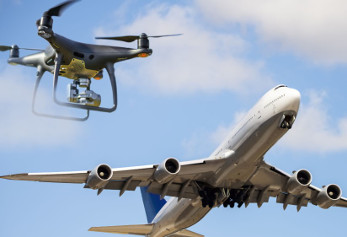The world’s largest and longest network of drone superhighways is one of the key projects supported by a £273m government cash injection into the low-carbon aerospace sector.
Supported with a £12.9m share, the Skyway team will build and develop 165 miles (265km) of ‘drone superhighways’ connecting airspace above Reading, Oxford, Milton Keynes, Cambridge, Coventry, and Rugby over the next two years to be used to survey infrastructure.
The project aims to remove the need for a human pilot within line of site of the drone by enabling any manufacturer to connect a drone’s guidance and communication systems into a virtual superhighway system.

This system aims to guide the drones safely through ‘corridors’ using only a software integration and higher-power sensors on the ground.
'This means drones don’t need to compromise payload, range or efficiency and can tap into even higher resolution data, from multiple sensors, from the ground-based network,' the team said.
Among the groups involved in the project are Reading, Oxfordshire and Coventry councils, and the Connected Places Catapult alongside a host of private sector companies in related sectors.
Aerospace Funds
Ministers announced £155m of joint government-industry funding to support green aerospace innovation projects. Among the 31 Aerospace Technology Institute (ATI) Programme competition winners are:
- High Density Aerospace Solar Power led by Microlink Devices UK - £6.7m to secure a high-volume, highly automated manufacturing capability in solar cells for the UK that could be used on electric aircraft
- UToPEA led by Yasa - - £11.1m to transfer knowledge of high-power, high-torque, super low weight electric motors and power electronics from premium automotive sector into the urban air mobility (electric air taxi) market. YASA’s aerospace division was spun-out as Evolito Ltd in 2021
- eXtra High Performance Wing led by Airbus – £19.9m to develop ultra-wide span wings, providing significant performance benefits through weight reduction
- NGC3 led by Crompton Technology Group - £5.3m to develop weight reduction components aimed at facilitating carbon composite wings
A further £105.5m of government-industry funding will be shared by projects under the Future Flight Challenge. The projects will work with the Civil Aviation Authority and include:
- Project HEART, based in Orkney and Bedford - £10m to explore using aircraft powered by hydrogen or electricity
- Open Skies Cornwall - £2.4m to work with Royal Mail and NHS Kernow to use drones to provide residents on the Isles of Scilly with regular, reliable deliveries of mail and medical supplies
- CAELUS 2, based across Scotland - £10.1m to use electric drones to support the distribution of medical products and medicines across Scotland
The remaining £12m from the total fund is to be made available through the Regulators’ Pioneer Fund to back initiatives that could unlock industries of the future through regulation – including 'flying cars', Government officials actually said. Bids for up to £1m per project will open on 21 July.
These announcements come alongside a Drone Ambition Statement outlining how government and industry can work together to realise an estimated £45bn of benefit to the economy by 2030 from drones.
This will be achieved through 'effective regulation, a consultation on enabling 5G connected drones for commercial use and improving public communications to underline the potential benefits of commercial drones'.
Transport minister Robert Courts said: 'The steps we have set out today will ensure our aviation sector remains world-leading and fit for the future, helping to deliver on our ambitious climate change goals and boost high-skilled job opportunities.
'Integrating drones into our transport system will play a huge part in better connecting communities, from potentially delivering vital NHS treatments in isolated communities to capturing high quality aerial imaging for rescue teams.'
The Aerospace Technology Institute estimates ATI Programme projects are set to secure 81,000 jobs, while contributing £97bn of economic value to the UK.




